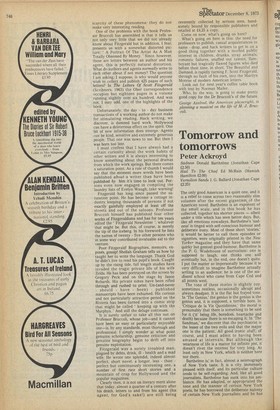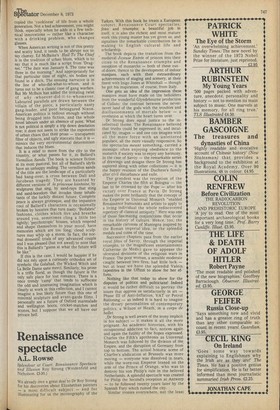Tomorrow and tomorrows
Peter Ackroyd
Sadness Donald Barthelme (Jonathan Cape £2.50) Hail To The Chief Ed McBain (Hamish Hamilton £2.00) Vermilion Sands J, G. Ballard (Jonathan Cape £2.25) The only good American is a quiet one, and it is a relief to come across two reasonably slim volumes after the recent gigantism„of the American novel. Barthelme is an exponent of the small scale, and in this book he has collected, together his shorter pieces — albeit under a title which has seen better days. But, like all emotions nowadays, Barthelme's 'sadness' is tinged with self-conscious humour and deliberate irony. Most of these short 'stories,' it would be better to call them episodes or vignettes, were originally printed in the New Yorker magazine and they have that same quirky but genteel good-humour, Barthelme is the P. G. Wodehouse of surrealism: one is supposed to laugh, one thinks one will eventually but, in the end, one doesn't quite. I put the matter so impersonally because it is very difficult to imagine Barthelme actually writing to an audience; he is one of the soidisant school who came from Cape Cod and all points west.
The tone of these stories is slightly coy, sometimes restless, occasionally abrupt and always deadpan. It is the flat but frayed tone. In 'The Genius,' the genius is the genius is the genius and, it is supposed, a terrible bore. In 'Critique de la Vie Quotidienne,' the moral is presumably that there is something to be said for it ('it' being life, boredom, heartache and ' death) because there is no escaping it. In 'The Sandman,' we discover that the psychiatrist is the lesser of the two evils and that the major one is the patient. All good ironic stuff; of courst, and I must admit to having been amused at intervals. But although the weariness of life is a matter for infinite jest, it doesn't rivet the interest for very long. At least only in New York, which is neither here nor there.
Barthelme is in fact, almost a seismograph of New York taste. It is a city immensely pleased with itself, and its particular culture tends to be self-regarding. And, like all good journalists, Barthelme has sunk into his ambiance. He has adapted, or appropriated the tone and the manner of certain New York poets, he has borrowed the deliberate naivety of certain New York journalists and he has
copied the 'cookiness' of life from a whole generation. Not a bad achievement, you might think, especially when he adds in a few technical innovations — rather like a character with a drinking problem, who changes' glasses.
When American writing is not of this pretty and scatty kind, it tends to be abrupt not to say clumsy. Ed McBains's Hail To The Chief is in the tradition of urban blues, which is to say that it is much like a script from 'Dragnet.' "The date was January 6. The time was three in the morning." And appropriately for that particular time of night, six bodies are found in a ditch. The ensuing narrative is in the line of who-did-what-to-whom, and it turns out to be a classic case of gang warfare. But Mr McBain has added the irritating twist of why -whoever-did-it-to-whomever. Laboured parallels are drawn between the villain of the piece, a particularly nasty gang-leader, and 'poor beleagured Nixon. American politics is tedious enough without being dragged into fiction, and the whole novel labours under an absence of point. What is not political is simply a trip down desolation row; it does not seem to strike the exponents of urban chaos that their prose — transparent filter of objects, and ugly staccato that it is — mimics the very environmental determinism that induces the blues.
It is a relief to move from the city to the country, or what passes for it, in Ballard's Vermilion Sands. The book is science fiction at its most pastoral, but all of Ballard's idylls have an unhappy ending. The vermilion sands of the title are the landscape of a particularly bad hang-over, a cross between Dali and Jacobean tragedy. They are haunted by different versions of la princesse lointaine, by sculptures that sing, by sand-rays that sting and sand-boredom that invades these inhabitants of the luckily distant future. Complete peace is always grotesque, and the impassive cool of Ballard's characters is occasionally broken by luxuries that turn nasty. 'Biofabric' fashions, clothes which live and breathe around you, sometimes cling a little too tightly; 'psychotropic' houses, which respond and shape themselves to your mood, have memories which are too long; cloud sculptures may whip up a storm. In fact, the normal domestic trials of any advanced couple and I was pleased (but not awed) to note that this is Ballard's "guess at what the future will be like."
If this is the case, I would be happier if he did not rely upon a curiously orthodox set of symbols: the Galahad, the Wicked Witch and La Belle Dame sans merci. Similarly, his prose Is a trifle florid, as though the future is the only safe place for lost romance. There is a once trendy 'camp' that tends to suffocate the odd and interesting imagination which is clearly at work in this collection, and I cannot imagine a less likely future than this one of minimal sculpture and avant-garde films. I Personally see a future of Oxford marmalade and wellington boots, cricket-matches and scones, but I suppose that we all have our private hell.











































 Previous page
Previous page